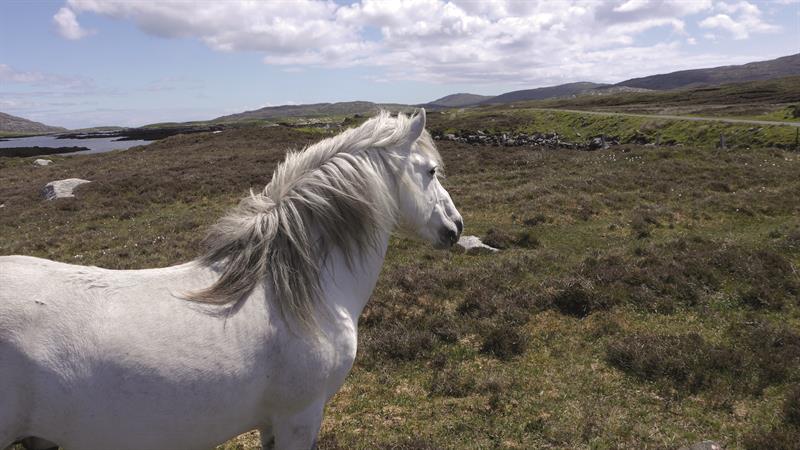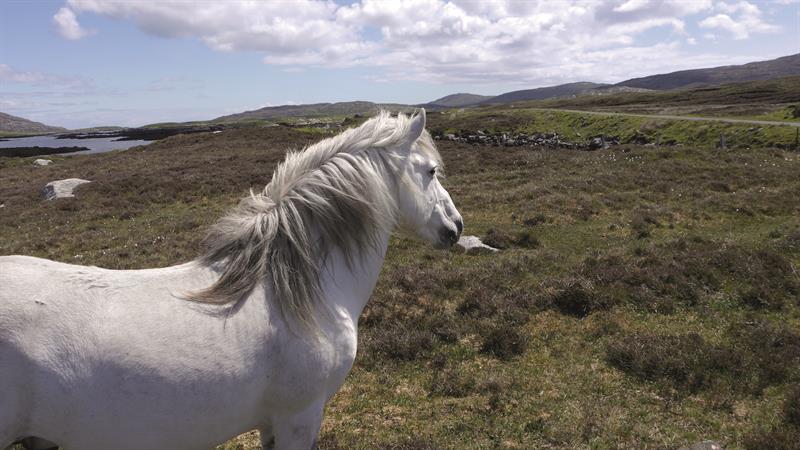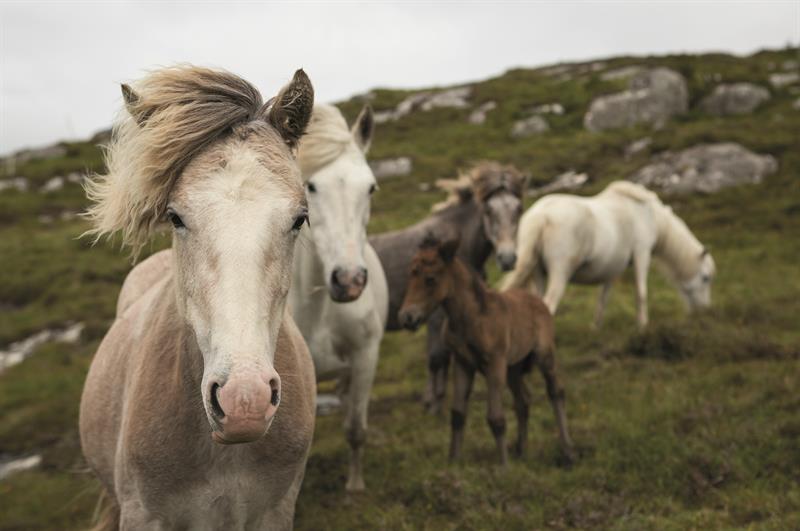Of all Scotland’s four native horse breeds – Shetlands, Highlands, Clydesdales and Eriskays – the last is by far the rarest. Susan Dunne discovers more about this endangered breed.

Native to the small outer Hebridean island of Eriskay, with a small semi-feral herd also running on Holy Isle, they have always been a numerically small breed. The remoteness of the island has helped to keep the breed pure as they managed to escape interbreeding with heavier draft horses but their rarity has brought the Eriskay close to extinction.
Hardy and Workmanlike
Standing between 12 and 13.2 hh, the ponies are most often grey with dense coats but not feathers. They are a stocky breed but have fine legs – and given the harsh conditions of Eriskay, are exceptionally hardy and able to survive on a sparse diet which includes seaweed. Traditionally used by crofters to carry baskets of peat and seaweed from the shore, they are workmanlike and versatile. They are also noted for their friendly disposition and love of human company – a reflection on their lives in close proximity with the Islanders, who would keep them in part of their own houses during the bitter winters.
Back from the Brink
The ponies had a brief moment of glory during the Second World War, as they helped the locals “rescue” nearly 25 000 bottles of whisky from a ship which had foundered off Eriskay. The story would be made famous in the Ealing Studio production of Whisky Galore, but post-War their fate was uncertain. In a familiar twentieth century story, this native breed came close to extinction with changing work practices and increased mechanization. By the 1970s there were only 20 Eriskay ponies and a single stallion, Eric, left. It is thanks to the hard work and dedication of a few interested locals – and Eric – that the breed has survived. Breed groups have been established across the British Isles and there are now approximately 420 Eriskays worldwide. They are classed as critical status by the Rare Breeds Survival Trust.
Lesley Goodden
Lesley Goodden showcased her tandem pair of Eriskays across the driving trials circuit, winning at national level, including at Windsor and three times as Indoor National Tandem Champion. She drove the ponies between 1994 and 2007 and although they are no longer with her, looks back on them with very positive memories.
She says: “I’d just retired my last horse, a Knabstrupper, after competing at Windsor when I was reading a piece in Horse and Hound about the Eriskay pony.” Intrigued, she contacted Anne Bell, who with her husband, a vet, has been instrumental in the breed’s preservation. A visit to Anne in Scotland saw Leslie returning with 3 unbroken Eriskays of the Linton prefix. Linton ben Ossie and Dougal both took to driving, although sadly Lesley lost Dougal to a twisted gut aged 9. She says of the breed “They are extremely hardy. They never had any limb problems even though they were competing hard. They are very, very hairy – I ended up having to clip mine in July!”
Surprisingly, another Eriskay was orthcoming from Brighton. Whilst Linton Luath, formerly owned by Jane Walsh, came with a few question marks over his head, Lesley says they clicked straight away: “He was known as a bit of a lunatic but he was a tandem leader through and through – in fact he’s the best tandem leader I’ve ever had. You never told him what to do, you always asked, but he really was a genius at his job. He and Ossie were cousins and they worked really well together – they were ponies of a lifetime.”
Lynda Hollis
Lynda Hollis owned a pair of Eriskays, having been introduced to them by Lesley. Brother and sister Morthana Crofly and Cuil Caspian lived together for the majority of their lives and at 12.3 and 13 hh respectively were very well matched. Lynda says: “They were very willing and biddable. You have to ask them and if it’s something they want to do they’ll be very easy to train. I wouldn’t say they’re a novice pony as they have their own way of doing things, but they are very loyal – they’ll follow you to the ends of the earth and they just love fuss and attention.”
Lynda broke her Eriskays to drive herself, and had great fun with them doing club events and pleasure drives. She found them strong hardy ponies: “An adult could ride them. I called them short legged horses because they could carry the weight of a man with no bother. They have something like a fourth pace – their trot is incredibly fast, even though they are not actually racing. Some people may have Eriskay ponies and not realize it! They’re sometimes confused with New Forests although they have a huge poll bone, probably much wider than any other native. We didn’t have any problems getting harness to fit – although for one of them we had a cob size bridle and a pony size harness.”
For further information: www.eriskaypony.com www.rbst.org.uk



This article first appeared in the August 2019 issue. Subscribe here to keep up to date with the world of Carriage Driving
